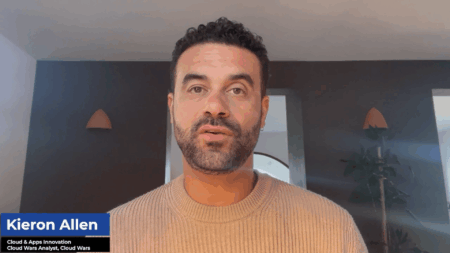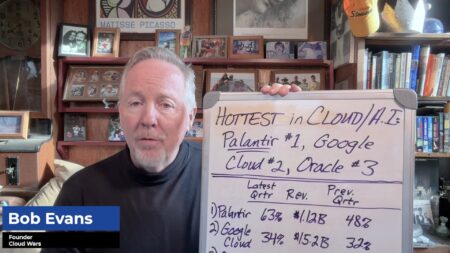Google Cloud has hired many thousands of people across the world and across the company since Thomas Kurian took over as CEO in January 2019, and you could make a very good case that the most important of all of those was president Rob Enslin.
On my weekly Cloud Wars Top 10 rankings, Google Cloud is #3—but before Kurian and Enslin joined, it was #9.
It’s ironic that Kurian and Enslin, before joining Google Cloud, were intense rivals for more than two decades: Kurian led product development at Oracle, and Enslin led global sales operations at SAP.
But in their time together at Google Cloud, Kurian and Enslin have combined to trigger this headline that I wrote two months ago: Google Becomes World’s Hottest Cloud Vendor with Q2 Blowout.
With Enslin leading global field operations and taking responsibility for tripling the size of the sales organization, Google Cloud has been on a high-growth tear culminating in Q2 revenue of $4.63 billion, up 54%. And while still much smaller than the cloud businesses of Microsoft and Amazon, Google Cloud is making impressive inroads by charting its own customer-centric path into the future and springing some powerful surprises on the entire marketplace, typified by this one from last week: Google Cloud Just Introduced the Most Important Product of the Year.
Kurian’s vision and strategy plus Enslin’s superb market knowledge and field leadership have produced an impressive string of quarterly growth rates since Google Cloud’s parent company began releasing financial details in 2020. Here are the quarterly growth rates generated by Kurian and Enslin for the 6 quarters since then:
- Q1 2020: 51.9%
- Q2 2020: 43.3%
- Q3 2020: 44.6%
- Q4 2020: 46.7%
- Q1 2021: 45.7%
- Q2 2021: 54% to $4.63 billion.
To gain some insights on what drove those remarkable numbers—after all, it’s quite rare for growth rates to increase as the revenue base gets larger—I recently had a fascinating conversation with Enslin in which he shared his thoughts on a wide range of subjects: corporate culture, mindsets, speed, leadership, customer centricity, Enslin’s view of the big question CEOs should be asking themselves. From that interview, here are my selections of Enslin’s most-compelling comments.
Tapping into All of Google
“It’s been 28 months since I’ve joined Google Cloud, and I came in with a very specific focus. And that was to hopefully bring data and data innovation to enterprises at scale. Having known the capabilities that Google Cloud had, I always felt that consumer innovation was ahead of enterprise innovation, and I always admired what Google had done from an innovation point of view, whether it being with automotive, or with Waymo or with DeepMind, and all these different areas. I was chomping at the bit to take that and help companies understand how it can help shape them and think through how they could utilize satellite technology, and Android, and Android TV, and Maps, and then be able to connect them and really help them.”
Scaling Up the Global Sales Organization
“To do that, 2-1/2 years ago we had to bring enterprise scale to Google Cloud. We had to suddenly get a better coverage model around the world. I really felt that we needed to move the conversation from techie conversation to the boardroom. And I remember the very first conversations I had with our salespeople. I said, “You can discuss Anthos to the nth degree, but when you’re in the boardroom, nobody’s going to understand it. So you better be able to take that technology and turn it into something that’s meaningful for companies that will shape them, and think through how they can be shaped…’
“So we came in, we focused on building out a partner ecosystem, becoming enterprise ready, hiring lots and lots of people that understood business processes but also understood what the future of business processes could be, and really set ourselves on a goal of becoming a meaningful cloud provider at scale in the industry.”
The Pandemic and the Ability to Touch Billions of People
“I think the scale to which cloud and cloud providers were able to cope and the flexible nature in which all of us operated truly took us beyond a kind of mindset I would say in March of 2020 where we were all just shocked and thought, ‘What could we do? Would we survive this? Would we be able to cope? Let’s rush up to all the supermarkets and fill our house with food in case we needed to survive for 14 days.’ Well, guess what? It’s 20 months later and we are still working through it, and multiple markets around the world, multiple countries, they’ve got different elevations. We’ve seen how some business have opened, and some businesses have closed. We’ve opened our airlines, we’ve closed airlines. But one thing it’s really taught us is we’re able to touch billions of people in meaningful ways, across a broad spectrum.
“Think about it: entertainment, the magic of entertainment. How do we stream today? Everybody’s got a plus something in their environment, on their phone, on the different devices. You’re constantly connected and streaming doesn’t happen because we’ve connected wire to wire. That has exploded because we’ve had network capacity. We’ve been able to architect network capacity.”
The Next-Generation Mindset
“In many ways, I view it as next-generation companies got an acceleration simply because they were ready for this. They didn’t know they were ready, but they were ready for this. Probably the company that was mentioned quite a bit during this timeframe, maybe in the wrong or right way, but you look at a social-media company like TikTok. The criteria around being in your house, looking for entertainment, not being able to move out, simply made that a natural. And there are others where they became natural. And so the older media companies had to move fast to enable that streaming. Many of them even moved in such ways that they actually acquired or they merged with other companies, and the whole industry in 20 months just completely moved in a massively different direction.”
(A great example of what Enslin’s describing here can be found in How Google Cloud Is Deutsche Banks’s Innovation Engine: 15 Examples.)
Leadership, Hatchets and Innovation
“But then there are other companies that would say, ‘Maybe it’s time to get out the hatchet and cut a lot of things and hide behind it and save as much money as we can and not do anything?’ But in fact in many cases the opposite happened. People looked at it and said, ‘Oh my gosh, this is an opportunity. The world will change, and we will have to be ready for when that happens. And therefore, we’re going to invest now to become ready.’ I look at financial institutions. Financial institutions said, ‘Hey, Google, can you help us figure out how to really understand personalization? Because we don’t believe that the bank in the future is going to be about a consumer going into a bank, or that people will just show up want to work in a fixed environment.”
The New World of Telehealth
“I would agree with you completely. When I talked to a friend of mine who runs a big telehealth company based in South America in Colombia and Peru, he said they digitally connected six million patients to their doctors. Just think about that. How do you do that in a world where we used to make a phone call to get an appointment, and then you were put on a piece of paper or if you’re lucky maybe on a calendar. And then you showed up and you waited. Just think about what an impact that will be on future of health—it’s been absolutely remarkable.”
The Power of Speed—and the Power of Belief
“A friend said to me, ‘Robert, if somebody back in 2019 had told us that we have to get all of our employees access to video immediately, I would have told my CEO that would be a 9-month project and would cost X amount of millions to achieve. And I will fill you in on our progress at the board meeting late this year. And, probably the pre-preparation work for that will cost us a couple of hundred thousand to figure out how we’re going to do it, who we’re doing to hire, write up a big plan, and all those things.’ But in fact, what happened? We did it in 24 hours.
“And it just shows you, I think that new mindset to your point has set in in the pharmaceutical industry and others where now people today are saying, ‘Hey, if we use data and we put enough CPUs to it and we have enough people thinking about it, outcomes can happen much faster. We don’t have to constrain our minds around this—we can drive it faster.”
Focus: How Do You Make the Customer Experience Better?
- “And I think when people focus on that, all the right answers get put in place. When you focus on helping your customer or your consumer have a much better experience, drive their revenue objectives, help them use technology in a way that is transformative for them, connect the dots, that’s when magic starts to happen.”
- “I think that resonates in our numbers, to be quite frank. And it goes back to the earlier discussion around if you focus what these customers or consumers want or what they need, and you deliver on that, good things happen. Obviously, this is a consumption-driven business. And so we have to work every day really hard to make customers successful. The more successful they are, the more successful we are. It’s actually a very simple equation.”
- “I’ve been in this industry a long time and my belief is that the sales motion has to evolve completely. And the abstraction is different from what it was in previous years—and by that I mean it never stops and that we are constantly in a cycle of understanding where we can help, how we can help, and how we benefit companies to move their business along constantly.”
- “When I speak to new people who are joining us, I speak to them about, ‘This is not about the initial sales motion. This is about you constantly engaging your customers. And your customer-success journey, you own. And the more you own it, the more rewards you will see for your engagement.’ And we know today that if a company uses us once, it’s great. If they use us 10 times, it’s phenomenal. If they continue to expand us, it gets even better.”
Stay Focused on “The Simple Things”
“I always try to boil things down to the most simple thing: show up every day; care more about your customers than others do; make certain you understand what their P&L looks like in your head. If their P&L is going to be better every day, I guarantee you, you will benefit from that. And that’s how you have to shape it with customers: understand them. Understand the details—always know the details about your customer. Listen to YouTube, listen to CEO speeches. In those speeches, they tell you where they want to go. They tell you what challenges they have. And map your thinking to that. Don’t try to sell them the cloud, sell them the outcomes that matter.”
What Every CEO Should Be Thinking About
“One of the most interesting opportunities in our industry is going to be the ability to consume AI applications at scale. I don’t think we’ve started yet—I think we’re only at the very, very beginning of AI at scale. And when I put myself in the eyes of my customers, if I were sitting in that CEO desk, my view would be, ‘How do I make certain that my organization is ready to take advantage of AI at scale?’
“And that, I think, is going to be one of the big and massive game-changers in the industry. And I can’t wait for us to produce hundreds of unbelievable AI applications that actually help customers, to your point, make the world better, bring things that are magically different. But in order to do that, humans are going to have to consume it, and we’re going to have to be ready for that. And I think that’s going to be very interesting as we go through that. Varies by industry, varies by digital native. This year’s digital native is next year’s traditional company.”
RECOMMENDED READING
How Google Cloud Is Deutsche Banks’s Innovation Engine: 15 Examples
Google Cloud Just Introduced the Most Important Product of the Year
Larry Ellison’s Next Conquest: Oracle Dives into Financial-Services Business
Database Wars: Oracle Attacks Amazon with High-Speed Upgrade
Dear Larry Ellison: Kudos on $10B Cloud Pace, but Can You Answer 3 Questions?
Microsoft Crushes Antiquated Business Model: Bravo!
Snowflake Shocker: Data Science Now Tops Life Sciences in Boosting Human Health
Market Cap Madness: ServiceNow Roars by IBM, $134 Billion to $125B
Disclosure: at the time of this writing, Google Cloud was among the many clients of Cloud Wars Media and/or Evans Strategic Communications LLC.
Subscribe to the Industry Cloud Newsletter, a free biweekly update on the booming demand from business leaders for industry-specific cloud applications.








